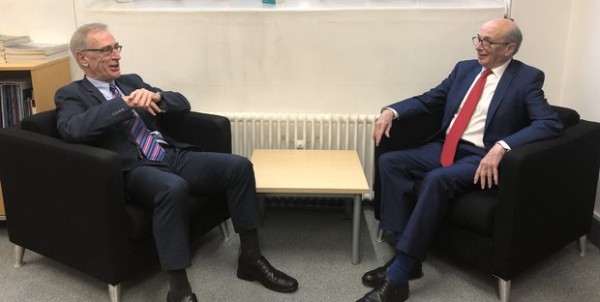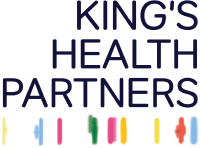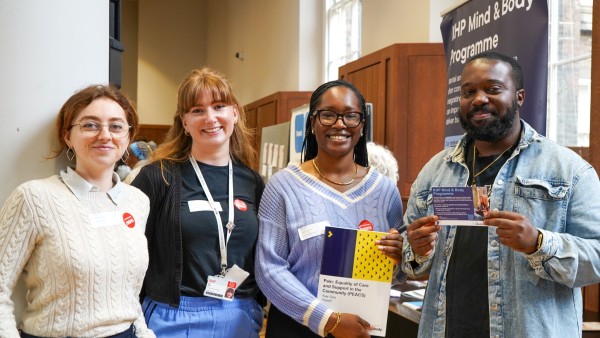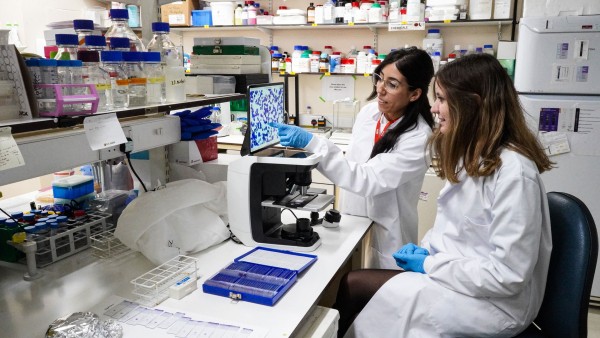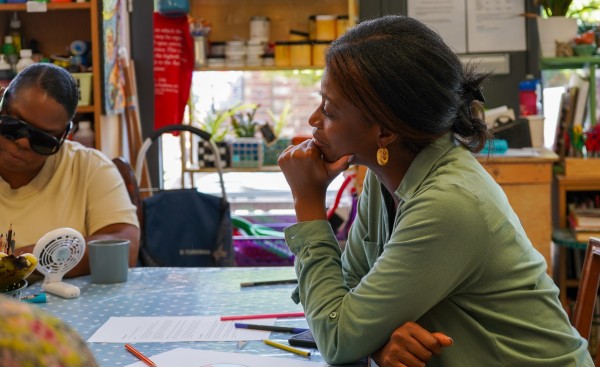7 November 2019
Two of the founding leaders of King’s Health Partners, Prof Sir Robert Lechler and Prof John Moxham, discuss the importance of clinical academic collaboration, lessons learned and opportunities for the future.
[L-R: Prof Sir Robert Lechler, Executive Director, King's Health Partners, and Prof John Moxham, recently retired Director of Value Based Healthcare, King's Health Partners.]
In July 2020, Prof Sir Robert Lechler will be stepping down from his roles as Executive Director of King's Health Partners and Senior Vice President/Provost (Health), King’s College London.
As Prof Sir Robert Lechler and Prof John Moxham were instrumental in the setting up of King’s Health Partners Academic Health Sciences Centre (AHSC) they took this opportunity to discuss the importance of clinical academic collaboration, lessons learned and opportunities for the future.
JM: This is an important conversation and it’s a privilege to be having it with you. King’s Health Partners has just celebrated its 10th Birthday and we held an Annual Conference in May to celebrate. You’ve announced that you are stepping down both as Senior Vice President/Provost (Health) and Executive Director at King’s Health Partners from July 2020. Tell us more about this decision.
RL: Delighted to do so. I think an important point to start with is that I have been at King’s College London for 15 years. In that time, my role has evolved. Initially, I came in as the Dean of the Medical School at King’s College London, I was then promoted to Vice-Principal (Health) and then I began in my role as Executive Director of King’s Health Partners. So, it’s certainly become ever more interesting while I’ve been here. However, 15 years is a long time. Ten years leading King’s Health Partners is a long time, and I think the time is right for fresh leadership. I would also like to have a little more freedom – I have worked continuously from the age of 23. In that time, the longest I’ve ever taken off work is two-weeks, which on reflection is extraordinary. So, although there are other things that I would like to do, and I will be staying on to serve our organisations in an advisory capacity, I believe passing the baton in July 2020 is the right thing for King’s College London and King’s Health Partners.
Having someone in a joint leadership position as Executive Director of King's Health Partners and Senior Vice President/Provost (Health), King’s College London, straddling the clinical and academic has helped to drive our shared ambition of bringing world-class research, education and clinical practice together for the benefit of patients.
JM: I was at the beginning of the AHSC journey with you more than 12 years ago as we began to think about a Clinical Academic Group (CAG) model for our AHSC. What are your reflections on the decisions we made at that time?
RL: If you start from the proposition that the purpose of an AHSC is fundamentally to be an engine room of innovation, to drive improvements in patient care and population health, then I think that it made sense that we adopted the most inclusive model that we could. Our vision was that everyone is ‘in’ and we would focus on the combined strength our partnership brings together. Our shared ambition was that we wanted ‘the tide to rise for all’ and I believe this is a distinctive feature of our AHSC, and one that I am very proud of.
I believe that to drive innovation you need a wide variety of skills and professional groups to be engaged and our CAG model very much reflects that.
The power of bringing together two acute trusts with a mental health trust and the university has been one of the greatest learning points for me on this journey. I am passionate about incorporating mental health into the heart of our partnership. This has been key to who we are, and again, another unique and distinguishing feature of our AHSC. I’m not aware of any other AHSC or academic medical centre in the world that has brought together mental and physical healthcare in the way we have. I honestly think that we are world-leading in this respect. I’m very proud of the sustained and consistent strength we have demonstrated through our Mind & Body programme.
JM: As you outlined, our core mission as an AHSC is to be an engine room of innovation and drive high impact innovation to improve patient care. The last 10 years have been extraordinary in this regard. Tell me about the key moments for you.
RL: It is very hard to narrow down the many great examples that we have. I believe we have seen the ‘tide rise for all’ and an extraordinary period of growth and achievement which we should reflect on and celebrate. There have been challenges, undoubtedly, but I think what we have achieved by working collaboratively, and by bringing our immensely talented staff together to work on delivering better outcomes has been exceptional. I want to thank our CAG Leaders and their teams for this incredible work. I believe we have seen a thousand flowers bloom through our collaborative work. What has impressed me most is that some of the most extraordinary successes we have seen have come from unexpected places.
Just some examples of this are, our Pharmaceutical Sciences CAG, which is unique as the world’s only formal healthcare/academic partnership in this field. Our Palliative Care CAG, who after only becoming a CAG formally just under two years ago has already made a real impact across education, research and clinical care. I would also highlight our Orthopaedics, Trauma and Plastics CAG, as they drive their sustained ambition to engage in clinical reconfiguration and research, making real progress on both fronts.
Another key moment for me is the evolution of CAGs into institutes. Again, highlighting the powerful things we can achieve when we come together. We are already seeing the early dividends of this, a good example of this in cardiovascular, where our consolidation and integration work has had a dramatic impact on survival after aortic dissection, length of stay after surgery and overall success in improving clinical outcomes.
Turning to examples of world-class innovations, our work in the treatment of one of the most common and disabling neurological disorders - migraine - is set to transform patient care and improve quality of life by significantly reducing the number of migraine episodes patients experience. The LEAP study of peanut allergy in children has led to a change in national guidelines and was recognised by the New England Journal of Medicine as one of the 12 most ‘practice-changing and lifesaving papers from the past 19 years’. And from basic science roots and curiosity-driven research, we have recently signed a major cross-country collaboration and license deal that could lead to a new class of pain medications that I hope will lead to hugely important new therapies for pain.
JM: These examples are so important because they show that when researchers have a line of sight to clinical care – real impact can be demonstrated. Which is what we are all trying to do.
JM: The environment for both the university and health sector has become ever more challenging. Whether its finance, performance indicators, expectations of the people we serve. How does the AHSC continue to add value?
RL: As an AHSC, I believe we do offer solutions to these challenges - we must do our part in contributing to the sustainability challenges we all face. This has been another great lesson for me on this journey. I must admit that in my very early career I was focused on discovering better ways to translate research into patient care, without much thought for sustainability.
Sustainability is a key aspect of how our AHSC can be part of the solution, rather than the problem.
Through our work in value based healthcare and novel diagnostics and therapeutics, we can deliver better outcomes in more sustainable models of care. We have even appointed the first-ever Professor of Frugal Innovation, which is a really exciting concept that I think is very refreshing and necessary.
Another aspect of this is our work in Global Health. We have country partnerships in Somaliland, Sierra Leone and the Democratic Republic of the Congo, where we support governments to strengthen healthcare and outcomes by empowering people, strengthening organisations and enhancing systems. Long-term health partnerships are an essential part of this work. For example, our team in Sierra Leone played a crucial role during the 2014 Ebola outbreak. Today, they still work in Sierra Leone, pursuing their original purpose of engaging with local agencies to strengthen their healthcare system. These activities are a great example of bringing our "local and global" mantra to life.
JM: It’s my reflection, that we can help lots of people in the system in which we work by getting much closer to our Primary Care partners, Clinical Commissioning Groups (CCGs) and Public Health colleagues. In particular, in the last couple of years, I feel they now look to us, and want to work with us to reduce health inequalities and improve outcomes, which for me, is a win-win situation.
RL: I agree, and much of that work has been a consequence of the profound influence you have had on local communities and national policy through your public health work, particularly in smoking reduction.
I have been very encouraged recently by the work we have begun with our local system partners, CCGs and Our Healthier South East London Sustainability and Transformation Partnership (STP). By working more closely together, we can reduce health inequalities and improve outcomes for our residents in south east London in a more sustainable model of care.
Also, by working closely with our local Academic Health Sciences Network (AHSN), the Health Innovation Network (HIN), we can improve translational learning, share innovations and build stronger networks of care to further maximise our collective strength.
In my view, one of the biggest steps we can take to make our healthcare systems more sustainable is getting serious about prevention. Because that is the most efficient way to start. I have great optimism that despite the rising costs of some of the things that we do, we will have a sustainable system by working in partnership as an AHSC, and across our wider system partners in south east London and beyond.
This is an exciting journey, and one that could not only positively impact the lives of the residents in our local communities but could spread to wider populations across south east England, and even lead to global impacts, all stemming from local innovation.
JM: You have recently made some important appointments to strengthen the Executive Team at King’s Health Partners. This has been part of a managed strategy to drive forward my portfolio of work as I retired in October, tell us more about that.
RL: First off, I will once again take the opportunity to say that you are irreplaceable, and I cannot emphasise strongly enough the contribution you have made and what a key partner you have been on this journey. However, we must do our best to replace you and we have made three very exciting appointments as Joint Directors of Clinical Strategy on the King's Health Partners leadership team. Dr Rachna Chowla, Dr Irem Patel and Dr Natasha Curran will take up these new sessional roles, to grow and improve primary care collaborations with our AHSC, develop programmes for population health improvement and further strengthen CAGs.
I think the three of them bring a very interesting and complementary set of skills to ensure that our clinical strategy continues to move forward.
King’s Health Partners has a strong leadership team. The commitment they show and our close working with Chairs, Chief Executives and senior leaders from our partners, demonstrates the belief we have in the added value of our AHSC and in what we can achieve together through close strategic alignment.
JM: In July 2020 you will formally step down from your roles here at King's Health Partners and King’s College London, but you will continue to serve our organisations in an advisory capacity. What else are you hoping to do?
RL: I would like to develop sides of my character that I have not had time to over the years. People may not be aware that I love art and music. I have become a trustee of the London Mozart Players, the longest established Chamber Music Group in the UK. My wife is Italian, and when we are fortunate enough to spend time in Italy one of my favourite past-times there is sketching. And I desperately want to improve my Italian.
Also, I would like to stay connected to the Life Sciences sector. Ideally at the interface between academia, healthcare and industry.
JM: A new competition for AHSCs has been launched for England, with submissions due by 11 December 2019. This is welcome news I imagine? What are the opportunities for King’s Health Partners?
RL: This is very welcome news. I have always believed there is merit in acknowledging that AHSCs are globally benchmarked centres of excellence. This designation gives us accountability to the Government through the Department of Health and Social Care. Through our application submission, we say what we are going to do, and then we must demonstrate our progress.
We have engaged with our partners and the wider healthcare system throughout the last year to develop a new five-year strategy, so work is well underway to determine our future direction.
Our new strategy will be ambitious, and signal ever closer working and integration with our partners and the health system, to deliver real benefit to our patients and population. Continuing to drive the engine room of innovation, translating research into the best patient care even faster, in more sustainable ways and ensuring that we develop, train and attract the best staff.
I think it’s a very good time for us to go into this new competition because we have such a great story to tell.
